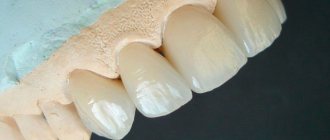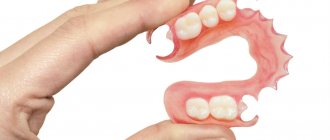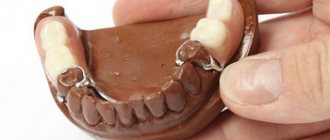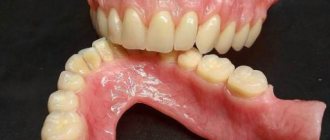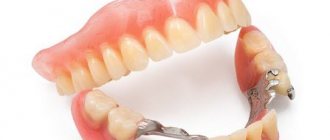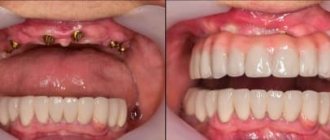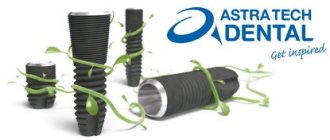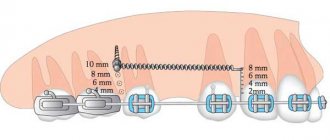From this article you will learn:
- types of fixed dentures on 4 implants,
- their cost, pros and cons,
- reviews on All-on-4 prosthetics.
The article was written by a practicing implantologist.
Dental prosthetics on 4 implants is an implantation technique that is used in the complete absence of teeth on the jaw and involves the installation of a permanent bridge prosthesis within the first 3 days after surgery. This technique was developed by the Swiss implant manufacturer Nobel-Biocare in 1998, and it is called All-on-4 (translated as “All on 4 implants”).
The surgical operation of installing 4 dental implants into the bone usually takes from 35 minutes to 1 hour, and then the prosthetic stage begins. The peculiarity of this technique is that at first your fixed prosthesis on 4 implants can only be temporary (i.e. adaptive). You will be able to use such a permanent prosthesis either for up to 5 months or for 2-3 years, which will depend on the design of the temporary prosthesis you choose and its cost. After this period, your temporary fixed prosthesis must be replaced with a permanent one.
Fixed denture on 4 implants –
As we said above, permanent All-on-4 prosthetics is carried out only in the second stage. If the patient has chosen an inexpensive option for a fixed temporary prosthesis (without a metal frame), permanent dental prosthetics All-on-4 is carried out after 5 months. If the temporary prosthesis was made on a metal frame, which greatly increases the cost of All-on-4, then re-prosthesis is carried out on average only after 2 years (maximum 3 years).
In this article we will talk about the features of temporary and permanent fixed dentures on 4 implants, and we will try to describe in simple words their differences from each other. You should also know that the cost of a temporary prosthesis will be included immediately in the price of All-on-4, but you will have to pay extra for a permanent prosthesis. The cost of dental prosthetics on 4 implants at the second stage will range from 150,000 to 550,000 rubles (depending on the type of permanent prosthesis).
All-on-4 prosthetic implantation scheme:
Prices
| Primary appointment (examination, consultation) with an orthopedic dentist | 1,150 rub. |
| Repeated appointment (examination, consultation) with an orthopedic dentist | 100 rub. |
| Dental prosthetics using an implant with an individual titanium abutment (without the cost of a crown) | 12,000 rub. |
| Dental prosthetics using an implant with an individual zirconium abutment with a titanium base (without the cost of a crown) | 15,000 rub. |
| Dental prosthetics using an implant with a permanent metal-free crown made of zirconium dioxide with screw fixation | 40,000 rub. |
| Dental prosthetics using an implant with a permanent metal-free all-ceramic Imax crown with cement fixation on a zirconium abutment | 47,000 rub. |
| Dental prosthetics with complete removable plate dentures (1 jaw) supported by implants on 4 locators | 80,000 rub. |
| Dental prosthetics with complete removable plate dentures (1 jaw) supported by implants on 4 ball-shaped abutments | 75,000 rub. |
| Dental prosthetics with complete removable plate dentures (1 jaw) supported by implants on a milled beam (without the cost of milling work) | 95,000 rub. |
Materials for dentures
To attach prostheses to implants, the material must be highly durable or have a metal base. This is necessary for the structure to withstand the load of the abutment (adapter).
Crowns for fixed structures are made from metal-ceramics, composite, metal-plastic, and also from zirconium dioxide. The prosthesis is attached using cement or screws.
Composite crowns for implants with a metal frame are used for single replacements, as well as for the installation of bridges. The design has a long service life (10-12 years) and is subject to repair. Reliable, lightweight, with a high degree of aesthetics, composite crowns are comfortable to wear and look like real teeth.
Plastic removable dentures last no more than 5 years and are used only for temporary or adaptive prosthetics. At EspaDent clinics, our specialists use more technologically advanced plastic for temporary prostheses. The composition contains crushed diamond chips, which makes the structure more resistant to stress during the fusion of the implant with the bone.
Fixed prosthesis is made of zirconium or metal ceramics. This is due to the high reliability of the design. Crowns for implants cannot be restored, as is the case with composite ones, so they must be as strong and durable as possible. For metal-ceramics, the service life is 8-10 years, and zirconium is a little longer - 15-17 years.
The disadvantages include the imperfect aesthetics of ceramic crowns - the metal base can be visible in the light. Therefore, it is better to use them to restore lateral teeth.
Zirconium dioxide crowns have almost no disadvantages. Decent service life, impeccable appearance, increased material strength, absence of allergic reactions even in patients with high sensitivity. Of course, such prostheses are more expensive than their analogues.
Types of dental prosthetics on implants
Crowns
This is the most aesthetic and popular type of dental prosthetics on implants. Crowns can be placed in the frontal and chewing areas. Typically, these designs are placed on the basis of one implant – one crown – one tooth. However, if several posterior units in a row are missing, bridges may be used as an alternative. In the frontal area, it is usually recommended to use single crowns. They are also used when the unit is partially left.
Bridges
The designs of this type of dental prosthetics on implants replace an entire fragment of the dentition. They are placed when the patient is missing 3-5 teeth in a row. Typically, 2-3 implants are installed in the oral cavity, onto which prostheses are attached, consisting of crowns, which are 2-4 units more than implants. Bridges are an ideal and relatively inexpensive option when it is necessary to compensate for the absence of several teeth at once.
Complete dentures
These are structures that are used to replace all missing teeth on one of the jaws. Complete dental prosthetics on implants has a number of important features. Firstly, different materials are used depending on the indications. The structure can be made of plastic, acrylic, metal ceramics, ceramic composite, zirconium dioxide. Secondly, complete dentures have different types of attachment.
Removable or fixed prosthesis on implants - which is better?
The choice of design depends not only on aesthetic preferences, but also on the duration of absence of teeth and the degree of atrophy of the jaw bones.
- If there is enough bone tissue, we can plan fixed prosthetics on implants without significant risks.
- If the bone deficiency is significant, to compensate for the distance between the jaws, bone grafting or the manufacture of a prosthesis with a massive base will be required.
Not all patients are financially and morally ready for bone augmentation. What remains is a prosthesis with an enlarged base, but this option involves difficulties in care. It must be removable so that a person can remove it independently for hygiene. In this case, there will be no risk of complications such as implant rejection.
If the patient has the desire or financial opportunity to switch from removable to fixed prosthetics, bone can be built up at the required points, the required number of implants can be added, and a fixed dental bridge can be installed.
Options for dental prosthetics on implants
Removable
Ideal for people who have previously worn removable dentures. To adapt the removable structure to prosthetics on implants, laboratory specialists attach special latches (attachments) to it. This option reduces the patient’s financial costs, since there is no need to make a new prosthesis. Most often, removable dentures on implants are a transitional stage before the installation of permanent dentures.
Partially removable and fixed dental prosthetics on implants
Today, in the vast majority of cases, patients are given prostheses that are not removable. Partially removable products can only be removed by a specialist in the clinic.
Gum contour.
A very important point in implant prosthetics is maintaining the gum contour. If an inexperienced implant surgeon misses this point, then the patient’s dissatisfaction may begin to express itself due to aesthetic complaints: the gums around the implant are blue, there are no gingival papillae, and they play a big role in the aesthetic component. To the point that over time (can happen in a very short time) the patient develops a problem with gum loss (gingival recession) and exposure of the implant neck. In our Es-Dent dental center, according to indications, close attention is paid to gum plastic surgery. If an implantologist says that a procedure with the gums is necessary, you should not ignore this stage of treatment in order to avoid problems after the installation of the prosthesis.
Why there are problems with gums.
- A person may naturally have thin gums. Its ideal thickness is 5 millimeters. If the patient’s skin is twice as thin, then one can definitely expect poor-quality aesthetics after prosthetics (if appropriate therapeutic measures are not taken). This will be, at a minimum, unsightly, and at maximum, it will lead to exposure of the implant.
- Attached gum. There may be a deficiency of this type of gum. Ideally, the gums should grow tightly together with the periosteum - this is the attached gum. But the second type is mobile. The results of ignoring gum surgery are the same as with the thin biotype.
The graft for gum plastic surgery is taken from the patient himself in certain places in the palatal space.
Methods of implantation
One-stage dental prosthetics on implants
Immediately after removing the problematic tooth, an implant is implanted in its place, and, if there are no contraindications, a temporary crown is fixed on it. In some cases, installation is carried out within 7-10 days.
One-stage dental prosthetics on implants (with immediate loading)
Implantation of the implant and its loading with a temporary crown occurs in one stage. After the structure has healed (after 3-6 months), the temporary crown is replaced with a permanent one.
Two-stage dental prosthetics on implants (with delayed load)
At the first stage, the patient is given an implant and a plug is fixed to it. After the structure has taken root, a gum former is placed, after 7-10 days it is removed and an abutment is placed, on which a permanent crown is then fixed.
Indications and contraindications for installation
An implant-supported prosthesis can restore one tooth, several adjacent units, or an entire row of teeth. However, the procedure involves surgery and therefore has a significant list of limitations.
Implantation is not performed if:
- poor clotting and other severe blood diseases;
- oncology;
- tuberculosis;
- connective tissue pathologies (lupus erythematosus, rheumatic disease, scleroderma);
- low level of immunity;
- inflammation of the mucous membranes of the mouth;
- problems with chewing muscles;
- mental disorders;
- diabetes mellitus in severe forms.
Temporary restrictions include jaw bone deficiency, dental diseases, addiction to alcohol, drugs, smoking, diseases of the nervous system, pregnancy, breastfeeding, and age under 18 years.
Types of dental prosthetics on implants with complete edentia
Ideally, to restore the dentition, it is best to replace each unit with a separate implant. But in practice, this is not always possible due to bone tissue atrophy, and the cost of treatment will be considerable. To solve this problem, Nobel Biocare has developed the innovative All-on-4 and All-on-6 concepts, with which it is possible to perform dental implant prosthetics even when there is a lack of bone tissue.
All-on-4. When using this technique, 4 implants are implanted into the jaw, onto which a fixed full denture for 12 teeth is fixed on the day of the operation. In the lateral parts of the jaw, pins are implanted at an angle, which ensures stability and stability of the structure. New teeth can be used immediately after installation. In the first months, while bone tissue is forming around the implants, the patient is given a temporary prosthesis. It is then replaced with a permanent structure. All-on-4 technology is optimal for the lower jaw, since the bone there is less susceptible to resorption.
All-on-6. This is an improved version of the All-on-4 technique, which involves adding two more supporting implants. Depending on the indications, they are installed in the distal or frontal part of the jaw. This technology is optimal for fixed prosthetics of the upper jaw, but can also be used in the lower jaw, when more supports for the prosthesis are required.
Why do you need 6 implants?
It has been clinically proven that six implants is the minimum required number for proper distribution of the chewing load without the risk of rejection and breakage of the entire structure :
- Even distribution on the jaw forces the bone to “work” along its entire length, and not just around the implants, as with fewer supports. This prevents bone loss in a certain area.
- Allows the installation of crowns made of durable zirconium dioxide. In smaller quantities, only plastic ones are available, which do not fully reproduce the natural appearance of teeth.
Eight implants may be required for the upper jaw - the bone is looser, not dense enough, and is more susceptible to atrophy. In this case, you can make a segmented prosthesis from 4 bridges; if necessary, only one part is removed. A single design is available on six implants; in case of any problems, it will have to be completely removed.
Each case is individual, it all depends on the parameters of the jaw. Only after examination and calculations will it be possible to say how many implants will be required for a fixed prosthesis specifically in your case.
How does implantation work?
The main stages of the procedure are:
- Consultation and diagnosis. The specialist assesses the current condition of the patient’s oral cavity, takes an x-ray, and prescribes a series of tests to exclude contraindications to implantation. Also at this stage, the functioning of the temporomandibular joint, the state of the bite are assessed, and the parameters of the closure of the teeth and the movement of the lower jaw are recorded. This information is needed to create a comfortable prosthesis that will not overload the implants.
- Bone tissue augmentation (if indicated).
- Implantation.
- Dental prosthetics on implants.
You can find out how much dental prosthetics on implants costs from our managers.
Computer examination is the key to high-quality prosthetics
An accurate examination determines the success of the entire process. In our Center it is carried out using a Sirona Galileos 3D tomograph.
- study of the size and characteristics of bone tissue
- determination of implant installation positions
- calculation of the required number of implants
Prosthetic methods
At the moment, there are two main methods of restoring teeth with complete edentia:
- Manufacturing of a complete or partial permanently fixed - i.e. FIXED (like your own teeth) or REMOVABLE prosthesis. In both cases, the prosthesis is fixed on implants.
The first method is considered more convenient and durable, while the second is often indicated for cases of extensive bone loss and the impossibility of augmentation (bone grafting). The patient has the opportunity to choose a removable or fixed option. If we take into account the recommendations of specialists, the best method is implantation followed by permanent prosthetics.
The administration of CELT JSC regularly updates the price list posted on the clinic’s website. However, in order to avoid possible misunderstandings, we ask you to clarify the cost of services by phone: +7
| Service name | price, rub) |
| Taking an autograft | 10 000 |
| Wax-up for implantations | 8 500 |
| Diagnostic impressions for implantations | 3 500 |
| Manufacturing and application of PRF membrane | 2 500 |
| Consultation with an implantologist (when conducting CT or OPTG studies at CELT - free of charge) | 1 500 |
| Bone material BIO-OSS | 11 000 |
| Bone material Osteomatrix | 5 000 |
| Membrane BIO-GUIDE PERIO | 15 000 |
| Osteomatrix membrane | 7 500 |
| Simple soft tissue plastic surgery in the area of 1 tooth | 10 000 |
| Complex soft tissue plastic surgery of 2-3 teeth | 15 000 |
| Simple plastic surgery of hard tissues (minor regeneration) | 7 500 |
| Complex plastic surgery of hard tissues (block) | 35 000 |
| Complex hard tissue plastic surgery (veneer) | 35 000 |
| Plastic surgery of hard tissues (membrane) | 20 000 |
| Opening the implant and installing the ASTRATECH gum former | 6 000 |
| Opening the implant and installing the INNO healing abutment | 5 000 |
| Sinus lift closed (soft) | 15 000 |
| Classic sinus lift | 35 000 |
| Transposition of the inferior alveolar nerve | 46 000 |
| Removal of a dental implant installed at JSC "CELT" | 2 000 |
| Removal of a dental implant not installed in CELT | 5 000 — 10 000 |
| INNO implant installation | 35 000 |
| Installation of the ASTRATECH implant | 60 000 |
| Installation of the MIS implant | 22 500 |
| Installation of an orthodontic implant | 15 000 |
| Implantation template | 12 000 |
Advantages and disadvantages
Dentures installed on implants have many advantages:
- allow you to quickly restore any number of lost teeth;
- no need to grind healthy teeth;
- aesthetic, look natural;
- do not interfere with diction, do not injure mucous membranes;
- distribute the chewing load evenly, allowing you to eat any food;
- stop bone tissue atrophy;
- do not shift, do not deform;
- easy to care for;
- unlike a living tooth, a titanium root is not susceptible to disease;
- The orthopedic structure can be replaced with a new one at any time.
Compared to the advantages, there are few disadvantages:
- wider list of contraindications;
- lack of experienced implantologists working with different treatment protocols;
- the price is higher.
Types of structures
In general, implant-supported prostheses are divided into two types:
- Removable.
- Fixed.
The first type differs significantly from analogues of classical prosthetics. Traditional structures are fixed exclusively on the gums, or attached to supporting teeth. Thanks to implants, removable dentures are securely fixed in the jawbone, but they can be removed if necessary. That's why they are called conditionally removable.
Fixed dentures are considered a more durable and optimal option for dental restoration. In addition to the artificial crown, some types of structures are equipped with a base made of elastic plastic, which imitates natural gums.
Fixed dentures can be used to replace any number of teeth, even if they are located in different parts of the dentition. We will talk in more detail about each type of prosthesis a little later.
There are also temporary dentures that are installed during the period of fusion of the implants with the jawbone. They maintain the aesthetics of the dentition and reduce the mechanical load on the pins, speeding up the healing process.
Temporary dentures look like removable structures that hook onto supporting healthy teeth using hooks. The most common option is a butterfly-shaped prosthesis. It is equipped with a plastic gum and two plastic holders for adjacent teeth. A denture replaces one or more teeth in a row.
Complete dental implantation in CELT
Full jaw implantation is one of the services of the CELT Dentistry Department. We guarantee high quality work. Our specialists provide complete information about the implants used, the advantages of the chosen technology and tell you how the process itself is carried out step by step. In addition, as a multidisciplinary clinic, we provide our patients with the service of complete dental implantation under anesthesia, provided by the staff of the anesthesiology and intensive care department.
Full complex implantation is carried out in our clinic using the most modern equipment and technologies. All procedures are painless: anesthesia is selected taking into account the individual characteristics of the patients. We use high-quality titanium implants from the budget segment “Implantium” and the premium segment “Astra Tech”.
High-quality full dental implantation at an affordable price ─ this is quite possible. Replacement of a complete dentition is possible using various methods, which will certainly be offered to you during the consultation.
How many implants are needed for partially missing teeth?
When calculating the number of implants, we take into account the distribution of chewing load
The load on the jaw when chewing should be uniform so that there is no subsidence of the gums and bone tissue under the hinged crowns. This will ensure the durability of the prosthesis and maintain aesthetics. Therefore, fixing a bridge on 2 implants is not always the right solution. It is recommended to use a 1:2 calculation - one implant for 2 crowns . Accordingly, the more teeth are missing, the more implants will be needed.
1-2 teeth missing
In this situation, bridges supported by implants are not relevant; teeth are restored separately. Each one has its own implant, which is covered with a separate crown. In this case, it is not recommended to combine crowns - if one is damaged, you will have to remove two at once. No 3 teeth
The most common clinical picture.
If there are no three adjacent teeth in a row, 2 implants are implanted along the edges of the defect, and a prosthesis for 3 teeth in the form of interconnected crowns is fixed on them. The outer ones are mounted on supports, and the middle one is hinged. You can install three implants, but this solution is cheaper. 4 missing teeth
When installing a bridge on 4 missing teeth in a row, the number of supports increases to three, and the number of crowns increases to four.
If you use two supports, then there will also be two mounted crowns. Atrophy of the jaw bone under the prosthesis cannot be ruled out due to uneven load. And the risk of prosthesis breakage increases due to increased pressure on the central part. No 5 teeth
Bridge prosthetics on implants is possible for 5 teeth or more. If five teeth are missing, three implants are needed. If a bridge of 6 teeth or more is required, three supports are used - the number is calculated by the number of crowns in the structure. The degree of future load and its distribution on the bone tissue are taken into account to prevent atrophy.


